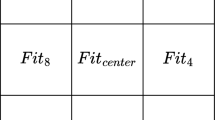Abstract
In this paper the multi-robot localization problem is addressed. A new framework based on a spatially structured genetic algorithm is proposed. Collaboration among robots is considered and is limited to the exchange of sensor data. Additionally, the relative distance and orientation among robots are assumed to be available. The proposed framework (MR-SSGA) takes advantage of the cooperation so that the perceptual capability of each robot is extended. Cooperation can be set-up at any time when robots meet, it is fully decoupled and does not require robots to stop. Several simulations have been performed, either considering cooperation activated or not, in order to emphasize the effectiveness of the collaboration strategy.
Similar content being viewed by others
Explore related subjects
Discover the latest articles and news from researchers in related subjects, suggested using machine learning.References
Parker LE (2000) Current state of the art in distributed robot systems. In: Proceedings of distributed autonomous robotic systems, vol 4
Kurazume R, Nagata S, Hirose S (1994) Cooperative positioning with multiple robots. In: IEEE international conference on robotics and automation
Rekleitis IM, Dudek G, Milios EE (2002) Multi-robot cooperative localization: a study of trade-offs between efficiency and accuracy. In: IEEE/RSJ international conference on intelligent robot and system
Rekleitis IM, Dudek G, Milios EE (2003) Probabilistic cooperative localization and mapping in practice. In: IEEE international conference on robotics and automation
Fox D, Burgard W, Kruppa H, Thrun S (2000) A probabilistic approach to collaborative multi-robot localization. Auton Robots 8(3): 325–344
Roumeliotis SI, Bekey GA (2002) Distributed multi-robot localization. IEEE Trans Robot Autom 18(5): 781–795
Mourikis AI, Roumeliotis SI (2006) Performance analysis of multi-robot Cooperative localization. IEEE Trans Robot 22(4): 666–681
Martinelli A, Pont F, Siegwart R (2005) Multi-robot localization using relative observation. In: IEEE international conference on robotics and automation
Martinelli A, Siegwart R (2005) Observability analysis for mobile robot localization. In: IEEE/RSJ international conference on intelligent robot and system
Gasparri A, Panzieri S, Pascucci F, Ulivi G (2007) A spatially structured genetic algorithm over complex networks for mobile robot localization. In: IEEE international conference on robotics and automation
Tomassini M (2005) Spatially structured evolutionary algorithms: artificial evolution in space and time (natural computing series). Springer, New York
Goldberg DE (1989) Genetic algorithms in search, optimization, and machine learning. Addison-Wesley, New York
Ashlock D, Smucker M, Walker J (1999) Graph Based Genetic Algorithms. In: Congress on evolutionary computation
Barabási AL, Reka A (1999) Emergence of scaling in random networks. Science 286: 509–512
Watts DJ, Strogatz SH (1998) Collective dynamics of ‘small-world’ networks. Nature 393: 440–442
Wang XF, Chen G (2003) Complex networks: small-world, scale-free and beyond. IEEE Circuits Syst Mag 3(1): 6–20
Author information
Authors and Affiliations
Corresponding author
Rights and permissions
About this article
Cite this article
Gasparri, A., Panzieri, S. & Pascucci, F. A spatially structured genetic algorithm for multi-robot localization. Intel Serv Robotics 2, 31–40 (2009). https://doi.org/10.1007/s11370-008-0025-4
Received:
Accepted:
Published:
Issue Date:
DOI: https://doi.org/10.1007/s11370-008-0025-4



